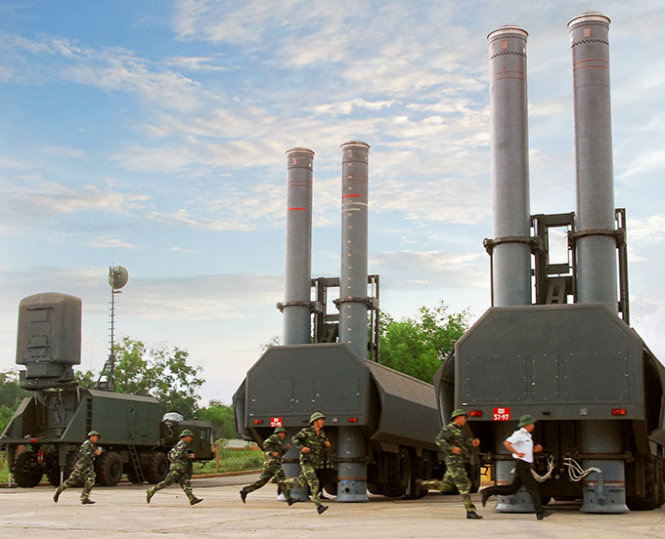A recent visit paid by a Tuoi Tre (Youth) newspaper reporter offers glimpses at the life, wholehearted dedication, and rigorous training of members of a brigade that operates the Russian-made Bastion-P missile system in south-central Vietnam.
>> An audio version of the story is available here
The Tuoi Tre reporter visited the 681 Coastal Defense Missile Brigade around the 60th birthday of the Vietnam People's Navy (May 7).
The brigade is stationed in the south-central province of Binh Thuan and it operates the Bastion-P missile system, one of the world’s most advanced coastal defense projectiles.
Apart from Russia, the Bastion-P producer, only Vietnam and Syria own such missiles.
The brigade was established in August 2006 and took over the missile system in 2010, according to Colonel Do Minh Tuan.
Brigade soldiers gained mastery of the system quickly after that and incorporated it into their combat deployment three months ahead of schedule, Col. Tuan said.
“With ‘bastion’ meaning fortification in the Russian language, the Bastion-P is dubbed ‘the wolf-pack missile system’ for its sheer power, which is manifest in its extensive attack range and high speed, among other features,” Senior Lieutenant Colonel Nguyen Dinh Tu, deputy commander of the brigade, explained.
These cutting-edge features help shield the missiles from enemy radar and render the enemies unable to react promptly even if they manage to detect the projectiles.
“The power of the Bastion-P missiles is currently unrivalled in the world,” Sr. Lt. Col. Tu noted.
Taxing training, persistent learning
One year before receiving the Bastion-P missile system, the first batch of officers, who were hand-picked from different naval units, were sent to Russia for training.
They struggled hard to surmount their initial overwhelming difficulties in learning Russian, and survive four mind-draining months of theory and practice.
Their efforts and persistence paid off, as they all passed the demanding tests with flying colors.
This first batch later passed on their expertise to younger generations at home.
What astounded the Tuoi Tre reporter during her visit is that many members of the force behind the state-of-the-art missile system are quite young, as they graduated from university only one or two years, even some months, earlier.
In 2013, Nguyen Thanh Huy, who was 24 years old and a fresh graduate back then, was named vice head of an inspection unit which is the heart of the engineering department.
His unit mostly comprises members in their 20s and early 30s. The unit leader is only 29.
“We take immense pride in our job and work under constant pressure with the highest sense of responsibility,” Huy, now 26, said.

The 681 Coastal Defense Missile Brigade is seen conducting a military parade on the 60th birthday of the Vietnam People's Navy (May 7). Photo: Tuoi Tre
Apart from rigorous technical and physical training, Huy and other young officers make a point of improving their professional skills and Russian command in the evening.
“The greatest challenge we’re faced with is whether we can fully harness the missile system to make the most out of its designed capacity. The system is a great asset of our people, so our mission is to ensure its utmost safety,” Sub Lieutenant Dau Trong Thai, 25, affirmed.
Another challenge is the lengthy dry season in Binh Thuan, Col. Tuan pointed out.
Binh Thuan is one of the provinces in the south-central region and the Central Highlands which have been writhing in an unforgiving drought spell in the past few months.
“There’s been no single rain drop since February. The rock-hard soil here makes it particularly difficult for us to grow plants,” Col. Tuan added.
Naval defense fortification
“The Bastion-P missile system’s mission is to safeguard the country’s coastline and ensure our warships’ safety in case of military conflicts,” Sr. Lt. Col. Tu, the brigade’s deputy commander, said.
Within a range of 300 kilometers, the missile system is capable of attacking all kinds of vessels, including battleships and planes.
“The system’s fire range makes it difficult for the enemy ships to approach it,” Tu noted.
Coastal defense missiles do not operate on their own but fight alongside other forces, including the air force, missile ships, and submarines, Col. Nguyen Hung Long, commander of the 681 Coastal Defense Missile Brigade, further explained.
“In times of military conflicts, the coastal defense missile soldiers always serve as the spearhead force whose mission is to ensure battle space to facilitate other forces’ combat,” Col. Long added.
“There’s thus no room for errors or failures on our side,” he stressed.
According to its producer, each Bastion-P missile system is capable of safeguarding a coastline of around 600km.
Only five minutes upon receipt of attack commands, the system can easily switch from the parade mode to the combat mode.
Missiles fired from the Bastion-P system have a cruise speed of M2.6 at 14km, where it can achieve a maximum range of 300km, or M2.0 at 10 to 20 meters, where it can reach a range of 120km, according to www.janes.com.
The system is highly mobile on any part of the coastline along the length of mainland Vietnam.
In 2007, Syria purchased two Bastion-P systems from Russia.
Three years later, Vietnam became the second country to be allowed to purchase the system from Moscow.
The Bastion-P system comprises two launchers, two Monolit-B radar vehicles, two combat command trucks, and one missile transporter loader.
During combat, the radar systems observe, keep track of the enemy target, and constantly update the commanders on the target’s parameters. The combat command trucks serve as miniature headquarters that give precise, prompt attack orders.
Those in charge of the self-propelled launchers are the last decisive factor in making or breaking the combat result.
Each of the launchers is armed with P-800 Oniks, which are supersonic anti-ship cruise missiles.
Like us on Facebook or follow us on Twitter to get the latest news about Vietnam!




















































